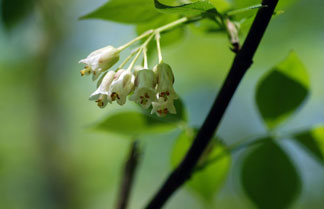AMERICAN BLADDERNUT
|
 |
| File Size: 37 KB |
|
|
|
Staphylea trifolia L.
|
| Jefferson County, Kansas |
| Height: To 10 feet |
| Family: Staphyleaceae - Bladderwort Family |
| Flowering Period: April, May |
|
| Trunks: | | Shrubs, rarely trees, erect, forming thickets from root-suckers; bark grayish brown, initially smooth, eventually fissured, somewhat flaky; wood white, hard. | | Twigs: | | Greenish brown to reddish brown, flexible, smooth or slightly furrowed, glabrous; leaf scars half-round; buds reddish brown, ovoid, .1 to .14 inch, apex obtuse, scales ciliate. | | Leaves: | | Deciduous, opposite, 3-foliolate, 2 to 10 inches; stipules falling early, linear, .4 to .6 inch; petiole 1 to 4 inches, glabrate or sparsely pubescent to velvety; leaflets elliptic to ovate or obovate, 1.6 to 3.6 inches long, .4 to 2 inches wide, base obtuse to truncate, margins minutely toothed, apex acuminate to cuspidate, abaxial surface pale green, sparsely to densely velvety, adaxial surface green, glabrate to sparsely velvety; terminal petiolule .4 to 1.4 inch, much longer than laterals. | | Flowers: | | Panicles, drooping, (2-)5-20-flowered, 2 to 2.4 inches; pedicels jointed, .24 to .45 inch, glabrous or sparsely velvety. Flowers bisexual, radially symmetric; sepals 5, distinct, oblong-ovate to oblong-triangular, .24 to .3 inch, glabrous, apex obtuse to acute, calyx campanulate; petals 5, white, erect, spatulate, .3 to .4 inch; stamens 5, inserted at margin of a disk, alternate with petals; pistil 1; styles 3, .16 to .2 inch, glabrous. | | Fruit: | | May and July; capsules in drooping clusters, yellowish green, papery-inflated, ellipsoid to ovoid or obovoid, 1.2 to 2 inches long, 1.2 to 1.6 inch wide, sparsely pubescent distally; seeds light brown to brown, ellipsoid to globose, ca. .25 inch, smooth, glossy. | | Habitat: | | Moist woods, along streams, thickets, or rocky, wooded hillsides; calcareous soils. | | Distribution: | | East 1/3 of Kansas. | | Origin: | | Native | | Uses: | | Native Americans steeped the powered bark and used the liquid as a wash for face sores and a wash to stop babies crying. A compound infusion made with the plant was used to treat rheumatism. The seeds were considered sacred and were used in rattles for medicine dances. | | Comments: | | American bladdernut is a common understory shrub of moist forests and woodlands in eastern Kansas. It is easily identified by its white flowers and inflated, 3-pointed fruits. Forms thickets. Fruit can remain on plant until winter. From Greek staphyle "bunch of grapes" alluding to the flower clusters. |
|
| American bladdernut inflorescence |  | | 29 KB | | Jefferson County, Kansas |
| | American bladdernut |  | | 39 KB | | Jefferson County, Kansas |
| | American bladdernut |  | | 49 KB | | Jefferson County, Kansas |
| | American bladdernut flowers |  | | 20 KB | | Jefferson County, Kansas |
| | American bladdernut leaf |  | | 39 KB | | Jefferson County, Kansas |
| | American bladdernut leaflets |  | | 57 KB | | Jefferson County, Kansas |
| | American bladdernut fruit |  | | 67 KB | | Johnson County, Kansas |
| | American bladdernut leaf |  | | 68 KB | | Johnson County, Kansas |
| | American bladdernut bud |  | | 29 KB | | Johnson County, Kansas |
| | American bladdernut bud |  | | 34 KB | | Johnson County, Kansas |
|
|
|
|












